2007 SUBARU TRIBECA warning light
[x] Cancel search: warning lightPage 282 of 377
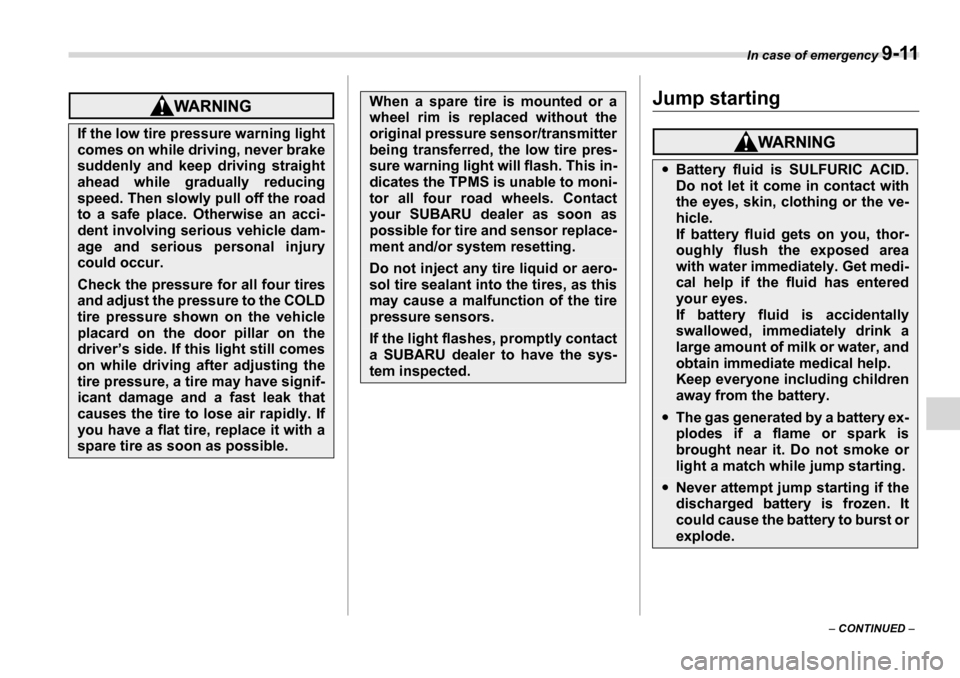
In case of emergency 9-11
– CONTINUED –
Jump starting
If the low tire pressure warning light
comes on while driving, never brake
suddenly and keep driving straight
ahead while gradually reducing
speed. Then slowly pull off the road
to a safe place. Otherwise an acci-
dent involving serious vehicle dam-
age and serious personal injury
could occur.
Check the pressure for all four tires
and adjust the pressure to the COLD
tire pressure shown on the vehicle
placard on the door pillar on the
driver’s side. If this light still comes
on while driving after adjusting the
tire pressure, a tire may have signif-
icant damage and a fast leak that
causes the tire to lose air rapidly. If
you have a flat tire, replace it with a
spare tire as soon as possible.
When a spare tire is mounted or a
wheel rim is replaced without the
original pressure sensor/transmitter
being transferred, the low tire pres-
sure warning light will flash. This in-
dicates the TPMS is unable to moni-
tor all four road wheels. Contact
your SUBARU dealer as soon as
possible for tire and sensor replace-
ment and/or system resetting.
Do not inject any tire liquid or aero-
sol tire sealant into the tires, as this
may cause a malfunction of the tire
pressure sensors.
If the light flashes, promptly contact
a SUBARU dealer to have the sys-
tem inspected.
�yBattery fluid is SULFURIC ACID.
Do not let it come in contact with
the eyes, skin, clothing or the ve- hicle.
If battery fluid gets on you, thor-
oughly flush the exposed area
with water immediately. Get medi-
cal help if the fluid has entered
your eyes.
If battery fluid is accidentally
swallowed, immediately drink a
large amount of milk or water, and
obtain immediate medical help.
Keep everyone including children
away from the battery.
�yThe gas generated by a battery ex-
plodes if a flame or spark is
brought near it. Do not smoke or
light a match while jump starting.
�yNever attempt jump starting if the
discharged battery is frozen. It
could cause the battery to burst or
explode.
Page 320 of 377
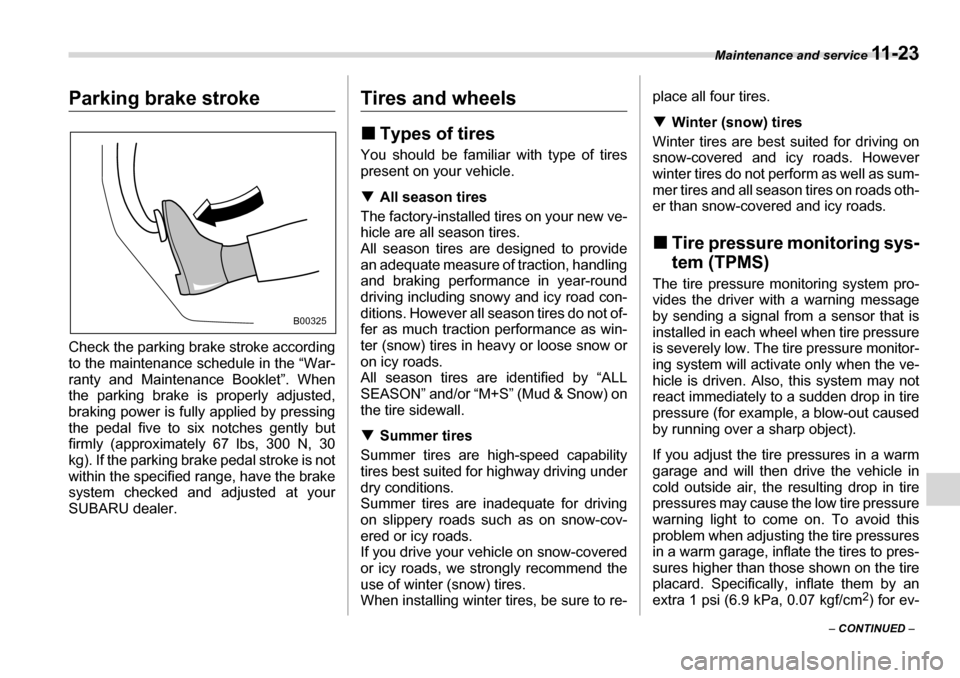
Maintenance and service 11 - 2 3
– CONTINUED –
Parking brake stroke
Check the parking brake stroke according
to the maintenance schedule in the “War-
ranty and Maintenance Booklet”. When
the parking brake is properly adjusted,
braking power is fully applied by pressing
the pedal five to six notches gently but
firmly (approximately 67 lbs, 300 N, 30
kg). If the parking brake pedal stroke is not
within the specified range, have the brake
system checked and adjusted at your
SUBARU dealer.Tires and wheels �„Types of tires
You should be familiar with type of tires
present on your vehicle. �T All season tires
The factory-installed tires on your new ve-
hicle are all season tires.
All season tires are designed to provide
an adequate measure of traction, handling
and braking performance in year-round
driving including snowy and icy road con-
ditions. However all season tires do not of-
fer as much traction performance as win-
ter (snow) tires in heavy or loose snow or
on icy roads.
All season tires are identified by “ALL
SEASON” and/or “M+S” (Mud & Snow) on
the tire sidewall. �T Summer tires
Summer tires are high-speed capability
tires best suited for highway driving under
dry conditions.
Summer tires are inadequate for driving
on slippery roads such as on snow-cov-
ered or icy roads.
If you drive your vehicle on snow-covered
or icy roads, we strongly recommend the
use of winter (snow) tires.
When installing winter tires, be sure to re- place all four tires. �T
Winter (snow) tires
Winter tires are best suited for driving on
snow-covered and icy roads. However
winter tires do not perform as well as sum-
mer tires and all season tires on roads oth-
er than snow-covered and icy roads. �„ Tire pressure monitoring sys- tem (TPMS)
The tire pressure monitoring system pro-
vides the driver with a warning message
by sending a signal from a sensor that is
installed in each wheel when tire pressure
is severely low. The tire pressure monitor-
ing system will activate only when the ve-
hicle is driven. Also, this system may not
react immediately to a sudden drop in tire
pressure (for example, a blow-out caused
by running over a sharp object).
If you adjust the tire pressures in a warm
garage and will then drive the vehicle in
cold outside air, the resulting drop in tire
pressures may cause the low tire pressure
warning light to come on. To avoid this
problem when adjusting the tire pressures
in a warm garage, inflate the tires to pres-
sures higher than those shown on the tire
placard. Specifically, inflate them by an
extra 1 psi (6.9 kPa, 0.07 kgf/cm 2
) for ev-
B00325
Page 321 of 377
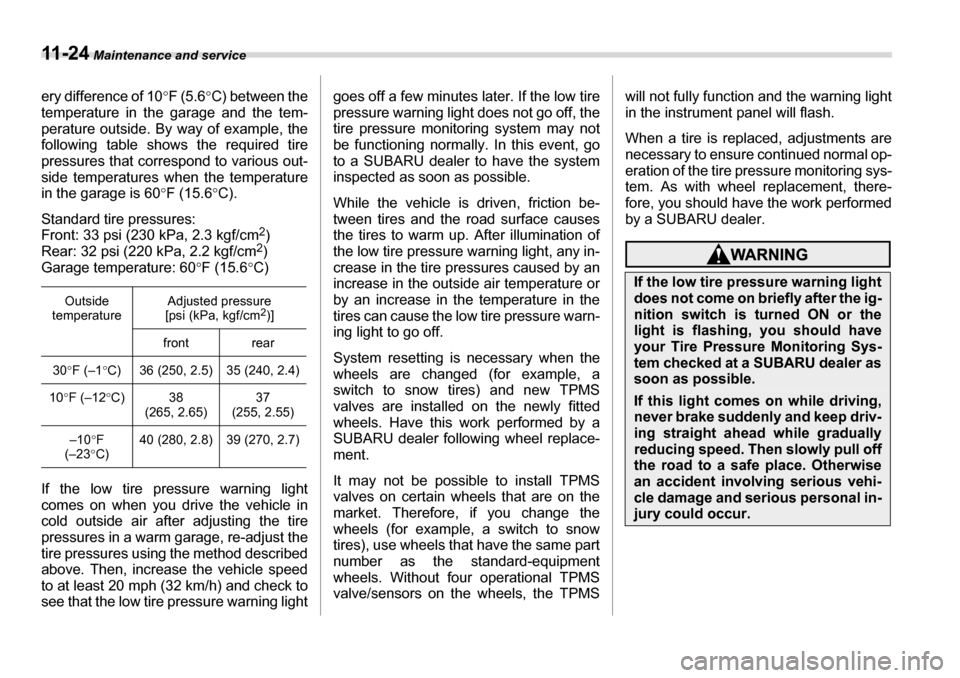
11 - 2 4 Maintenance and service
ery difference of 10 °F (5.6 °C) between the
temperature in the garage and the tem-
perature outside. By way of example, the
following table shows the required tire
pressures that correspond to various out-
side temperatures when the temperature
in the garage is 60 °F (15.6 °C).
Standard tire pressures:
Front: 33 psi (230 kPa, 2.3 kgf/cm 2
)
Rear: 32 psi (220 kPa, 2.2 kgf/cm 2
)
Garage temperature: 60 °F (15.6 °C)
If the low tire pressure warning light
comes on when you drive the vehicle in
cold outside air after adjusting the tire
pressures in a warm garage, re-adjust the
tire pressures using the method described
above. Then, increase the vehicle speed
to at least 20 mph (32 km/h) and check to
see that the low tire pressure warning light goes off a few minutes later. If the low tire
pressure warning light does not go off, the
tire pressure monitoring system may not
be functioning normally. In this event, go
to a SUBARU dealer to have the system
inspected as soon as possible.
While the vehicle is driven, friction be-
tween tires and the road surface causes
the tires to warm up. After illumination of
the low tire pressure warning light, any in-
crease in the tire pressures caused by an
increase in the outside air temperature or
by an increase in the temperature in the
tires can cause the low tire pressure warn-
ing light to go off.
System resetting is necessary when the
wheels are changed (for example, a
switch to snow tires) and new TPMS
valves are installed on the newly fitted
wheels. Have this work performed by a
SUBARU dealer following wheel replace- ment.
It may not be possible to install TPMS
valves on certain wheels that are on the
market. Therefore, if you change the
wheels (for example, a switch to snow
tires), use wheels that have the same part
number as the standard-equipment
wheels. Without four operational TPMS
valve/sensors on the wheels, the TPMS
will not fully function and the warning light
in the instrument panel will flash.
When a tire is replaced, adjustments are
necessary to ensure continued normal op- eration of the tire pressure monitoring sys-
tem. As with wheel replacement, there-
fore, you should have the work performed
by a SUBARU dealer.
Outside
temperature Adjusted pressure
[psi (kPa, kgf/cm 2
)]
front rear
30 °F (–1 °C) 36 (250, 2.5) 35 (240, 2.4)
10 °F (–12 °C) 38
(265, 2.65) 37
(255, 2.55)
–10 °F
(–23 °C) 40 (280, 2.8) 39 (270, 2.7)
If the low tire pressure warning light
does not come on briefly after the ig-
nition switch is turned ON or the
light is flashing, you should have
your Tire Pressure Monitoring Sys-
tem checked at a SUBARU dealer as
soon as possible.
If this light comes on while driving,
never brake suddenly and keep driv-
ing straight ahead while gradually
reducing speed. Then slowly pull off
the road to a safe place. Otherwise
an accident involving serious vehi-
cle damage and serious personal in-
jury could occur.
Page 322 of 377
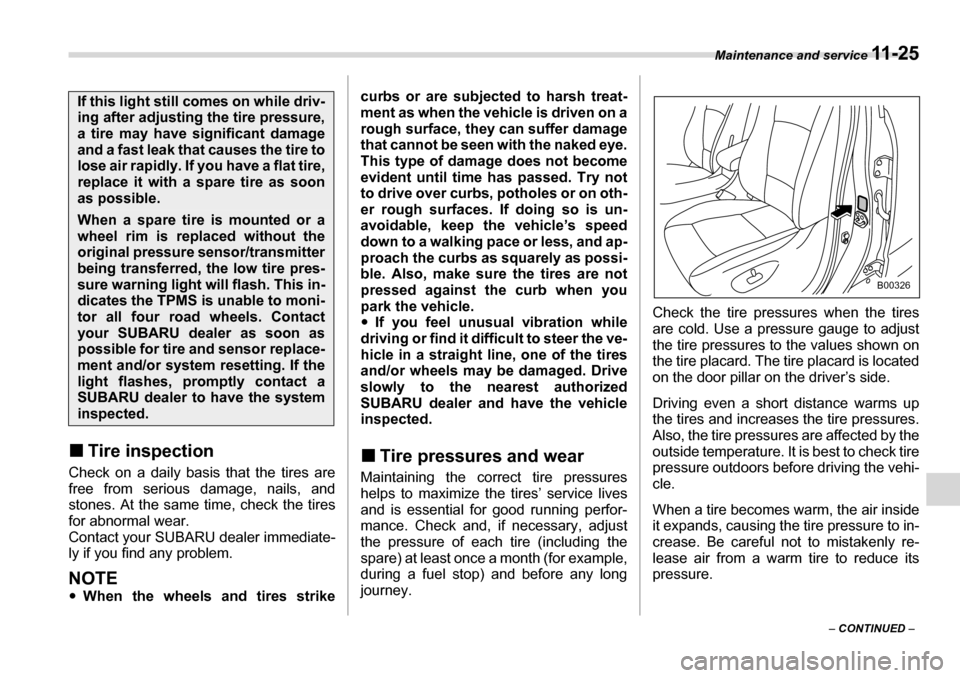
Maintenance and service 11 - 2 5
– CONTINUED –
�„
Tire inspection
Check on a daily basis that the tires are
free from serious damage, nails, and
stones. At the same time, check the tires
for abnormal wear.
Contact your SUBARU dealer immediate-
ly if you find any problem.
NOTE �y When the wheels and tires strike curbs or are subjected to harsh treat-
ment as when the vehicle is driven on a
rough surface, they can suffer damage
that cannot be seen with the naked eye.
This type of damage does not become
evident until time has passed. Try not
to drive over curbs, potholes or on oth-
er rough surfaces. If doing so is un-
avoidable, keep the vehicle’s speed
down to a walking pace or less, and ap-
proach the curbs as squarely as possi-
ble. Also, make sure the tires are not
pressed against the curb when you
park the vehicle. �y
If you feel unusual vibration while
driving or find it difficult to steer the ve-
hicle in a straight line, one of the tires
and/or wheels may be damaged. Drive
slowly to the nearest authorized
SUBARU dealer and have the vehicle
inspected. �„ Tire pressures and wear
Maintaining the correct tire pressures
helps to maximize the tires’ service lives
and is essential for good running perfor-
mance. Check and, if necessary, adjust
the pressure of each tire (including the
spare) at least once a month (for example,
during a fuel stop) and before any long
journey. Check the tire pressures when the tires
are cold. Use a pressure gauge to adjust
the tire pressures to the values shown on
the tire placard. The tire placard is located
on the door pillar on the driver’s side.
Driving even a short distance warms up
the tires and increases the tire pressures. Also, the tire pressures are affected by the
outside temperature. It is best to check tire
pressure outdoors before driving the vehi- cle.
When a tire becomes warm, the air inside
it expands, causing the tire pressure to in-
crease. Be careful not to mistakenly re-
lease air from a warm tire to reduce its
pressure.
If this light still comes on while driv-
ing after adjusting the tire pressure,
a tire may have significant damage
and a fast leak that causes the tire to
lose air rapidly. If you have a flat tire,
replace it with a spare tire as soon
as possible.
When a spare tire is mounted or a
wheel rim is replaced without the
original pressure sensor/transmitter
being transferred, the low tire pres-
sure warning light will flash. This in-
dicates the TPMS is unable to moni-
tor all four road wheels. Contact
your SUBARU dealer as soon as
possible for tire and sensor replace-
ment and/or system resetting. If the
light flashes, promptly contact a
SUBARU dealer to have the system
inspected.
B00326
Page 327 of 377
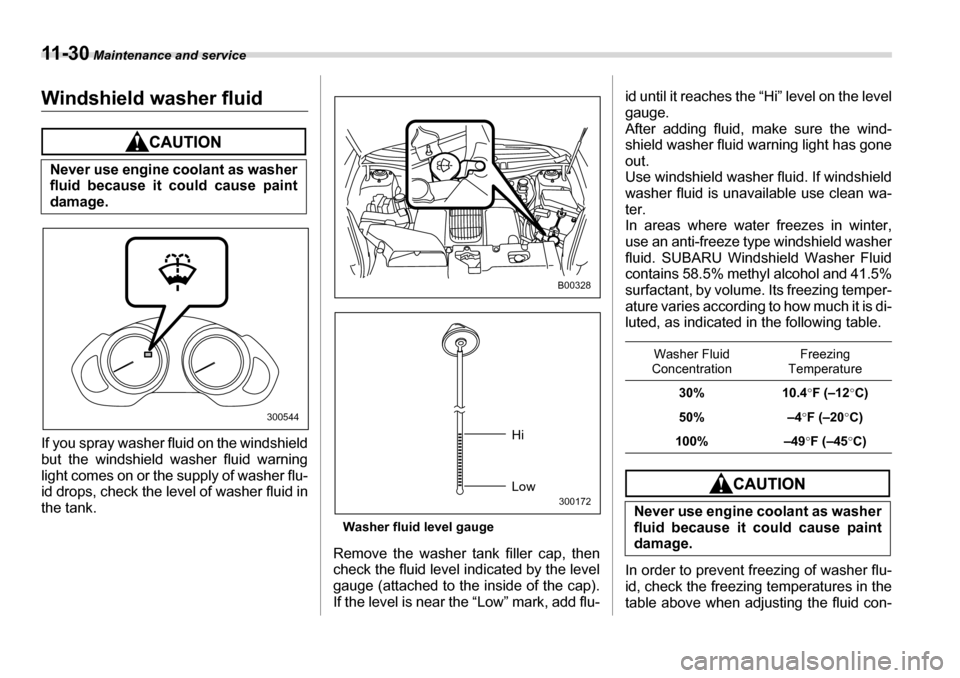
11 - 3 0 Maintenance and service
Windshield washer fluid
If you spray washer fluid on the windshield
but the windshield washer fluid warning
light comes on or the supply of washer flu-
id drops, check the level of washer fluid in
the tank.
Washer fluid level gauge
Remove the washer tank filler cap, then
check the fluid level indicated by the level
gauge (attached to the inside of the cap).
If the level is near the “Low” mark, add flu- id until it reaches the “Hi” level on the level
gauge.
After adding fluid, make sure the wind-
shield washer fluid warning light has gone out.
Use windshield washer fluid. If windshield
washer fluid is unavailable use clean wa-
ter.
In areas where water freezes in winter,
use an anti-freeze type windshield washer
fluid. SUBARU Windshield Washer Fluid
contains 58.5% methyl alcohol and 41.5%
surfactant, by volume. Its freezing temper-
ature varies according to how much it is di-
luted, as indicated in the following table.
In order to prevent freezing of washer flu-
id, check the freezing temperatures in the
table above when adjusting the fluid con-
Never use engine coolant as washer
fluid because it could cause paint
damage.
300544
B00328
Hi Low
300172
Washer Fluid
Concentration Freezing
Temperature
30% 10.4 °F (–12 °C)
50% –4 °F (–20 °C)
100% –49 °F (–45 °C)
Never use engine coolant as washer
fluid because it could cause paint
damage.
Page 350 of 377
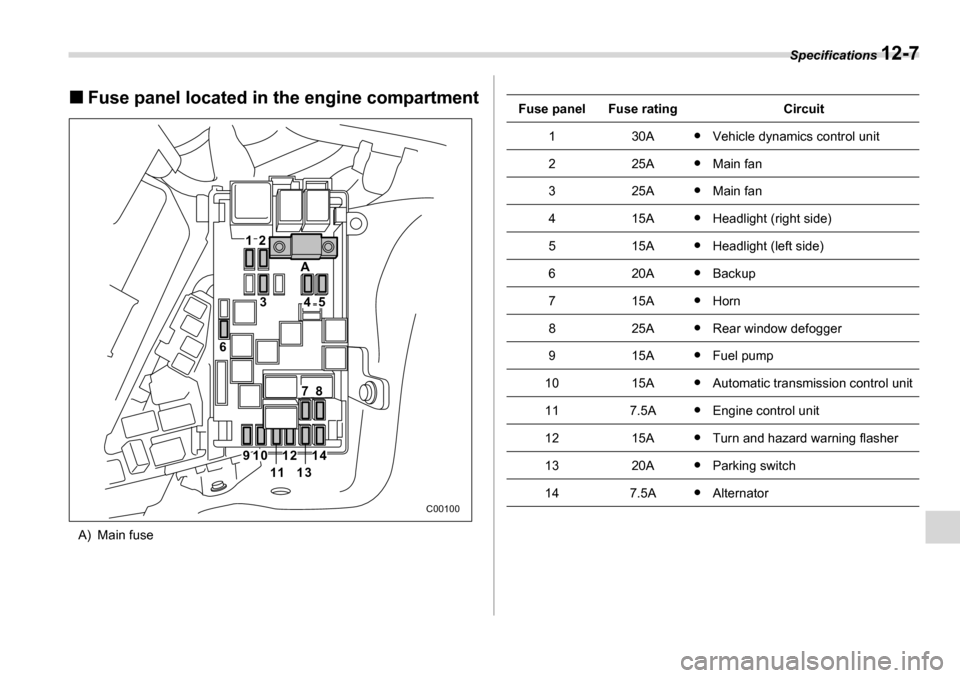
Specifications 12-7
�„Fuse panel located in the engine compartment
A) Main fuse
21
3
A
6
78
910
1113
1214
45
C00100
Fuse panelFuse ratingCircuit
130A�y Vehicle dynamics control unit
225A�yMain fan
325A�yMain fan
415A�yHeadlight (right side)
515A�yHeadlight (left side)
620A�yBackup
715A�yHorn
825A�yRear window defogger
915A�yFuel pump
1015A�yAutomatic transmission control unit
117.5A�yEngine control unit
1215A�yTurn and hazard warning flasher
1320A�yParking switch
147.5A�yAlternator
Page 369 of 377
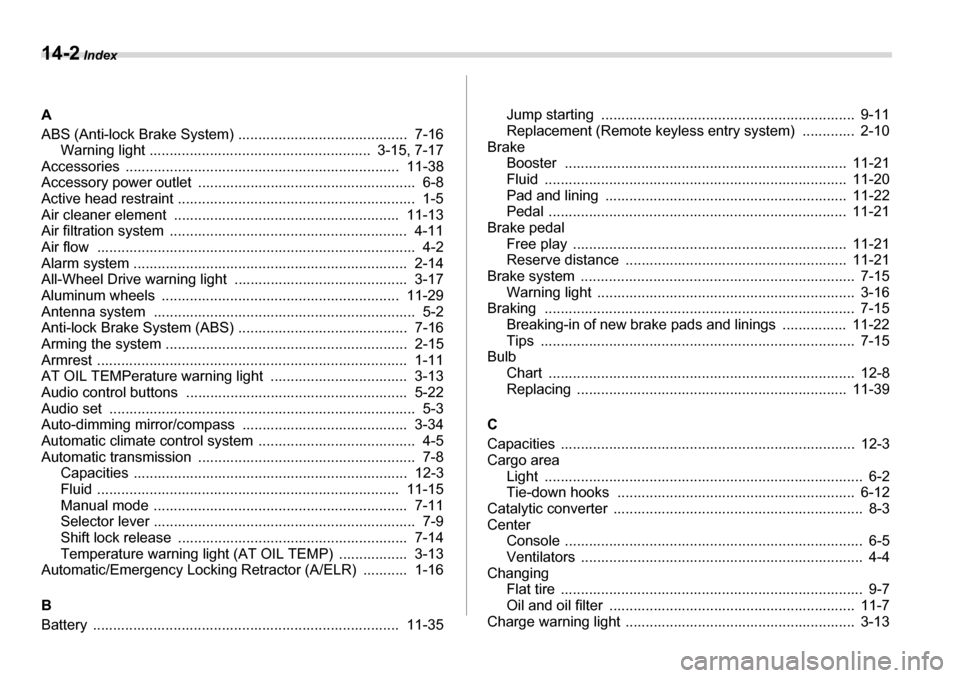
14-2 Index
A
ABS (Anti-lock Brake System) .......................................... 7-16 Warning light ....................................................... 3-15, 7-17
Accessories .................................................................... 11-38
Accessory power outlet ...................................................... 6-8
Active head restraint ........................................................... 1-5
Air cleaner element ........................................................ 11-13
Air filtration system ........................................................... 4-11
Air flow ............................................................................... 4-2
Alarm system .................................................................... 2-14
All-Wheel Drive warning light ........................................... 3-17
Aluminum wheels ........................................................... 11-29
Antenna system ................................................................. 5-2
Anti-lock Brake System (ABS) .......................................... 7-16
Arming the system ............................................................ 2-15
Armrest ............................................................................. 1-11
AT OIL TEMPerature warning light .................................. 3-13
Audio control buttons ....................................................... 5-22
Audio set ............................................................................ 5-3
Auto-dimming mirror/compass ......................................... 3-34
Automatic climate control system ....................................... 4-5
Automatic transmission ...................................................... 7-8 Capacities .................................................................... 12-3
Fluid ........................................................................... 11-15
Manual mode ............................................................... 7-11
Selector lever ................................................................. 7-9
Shift lock release ......................................................... 7-14
Temperature warning light (AT OIL TEMP) ................. 3-13
Automatic/Emergency Locking Retractor (A/ELR) ........... 1-16 B
Battery ............................................................................ 11-35 Jump starting ............................................................... 9-11
Replacement (Remote keyless entry system) ............. 2-10
Brake
Booster ...................................................................... 11-21
Fluid ........................................................................... 11-20
Pad and lining ............................................................ 11-22
Pedal .......................................................................... 11-21
Brake pedal
Free play .................................................................... 11-21
Reserve distance ....................................................... 11-21
Brake system .................................................................... 7-15
Warning light ................................................................ 3-16
Braking ............................................................................. 7-15 Breaking-in of new brake pads and linings ................ 11-22
Tips .............................................................................. 7-15
Bulb Chart ............................................................................ 12-8
Replacing ................................................................... 11-39
C
Capacities ......................................................................... 12-3
Cargo area Light ............................................................................... 6-2
Tie-down hooks ........................................................... 6-12
Catalytic converter .............................................................. 8-3
Center Console .......................................................................... 6-5
Ventilators ...................................................................... 4-4
Changing
Flat tire ........................................................................... 9-7
Oil and oil filter ............................................................. 11-7
Charge warning light ......................................................... 3-13
Page 370 of 377

Index 14-3
CHECK ENGINE warning light/Malfunction indicator
lamp .............................................................................. 3-12
Checking Brake pedal free play ................................................. 11-21
Brake pedal reserve distance .................................... 11-21
Engine oil level ............................................................ 11-7
Fluid level ............................................ 11-15, 11-19, 11-20
Gear oil level .............................................................. 11-17
Child restraint systems ..................................................... 1-30
Installation with seatbelt .............................................. 1-33
Lower and tether anchorages ...................................... 1-38
Child safety ............................................................................ 5
Locks ........................................................................... 2-19
Chime
Key ................................................................................ 3-4
Seatbelt ....................................................................... 1-17
Cleaning
Aluminum wheels ........................................................ 10-3
Interior ......................................................................... 10-4
Ventilator grille ............................................................. 4-10
Climate control system ....................................................... 4-5
Clock ................................................................................ 3-21
Coat hook ......................................................................... 6-10
Cooling system ............................................................... 11-10
Corrosion protection ................................................ 8-10, 10-3
Cruise control ................................................................... 7-27
Set indicator light ......................................................... 3-20
Cup holder .......................................................................... 6-6 D
Daytime running light system ........................................... 3-27
Differential gear oil Front ........................................................................... 11-16
Rear ........................................................................... 11-17
Dimensions ....................................................................... 12-2
Disarming the system ....................................................... 2-16
Disc brake pad wear warning indicators ........................... 7-16
Dome light ................................................................ 6-2, 11-44
Door locks ........................................................................... 2-4
Door open warning light .................................................... 3-17
Drive belts ....................................................................... 11-15
Driving All-Wheel Drive vehicle ................................................ 3-17
Car phone/cell phone ........................................................ 7
Drinking ............................................................................. 6
Drugs ................................................................................ 6
Foreign countries ........................................................... 8-4
Pets ................................................................................... 7
Snowy and icy roads ...................................................... 8-9
Tips ....................................................................... 7-13, 8-4
Tired or sleepy .................................................................. 7
E
Electrical system ............................................................... 12-3
Electronic Brake Force Distribution (EBD) system ........... 7-18
Emergency Locking Retractor (ELR) ................................ 1-16
Engine Compartment overview ................................................ 11-6
Coolant ....................................................................... 11-11
Exhaust gas (Carbon monoxide) ................................... 8-2
Hood ............................................................................ 11-4
Oil ................................................................................. 11-7
Overheating ................................................................. 9-14
Starting ........................................................................... 7-7